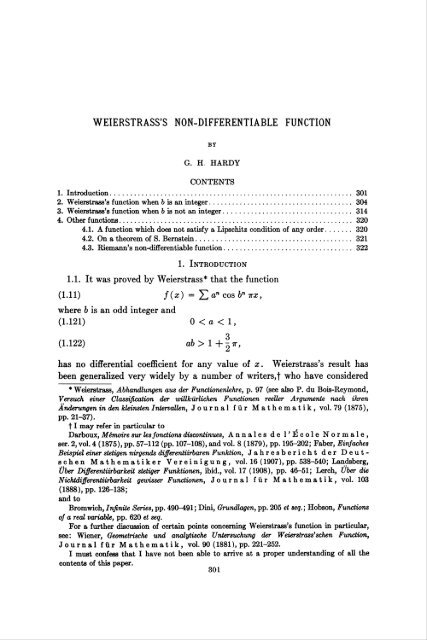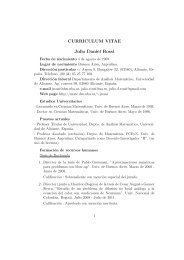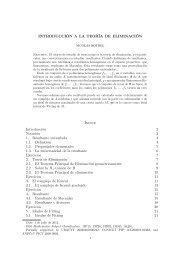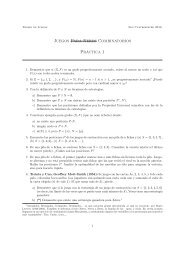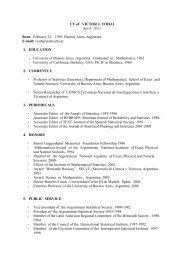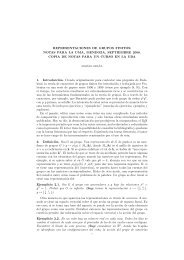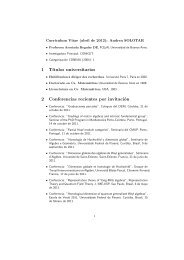WEIERSTRASS'S NON-DIFFERENTIABLE FUNCTION
WEIERSTRASS'S NON-DIFFERENTIABLE FUNCTION
WEIERSTRASS'S NON-DIFFERENTIABLE FUNCTION
You also want an ePaper? Increase the reach of your titles
YUMPU automatically turns print PDFs into web optimized ePapers that Google loves.
<strong>WEIERSTRASS'S</strong> <strong>NON</strong>-<strong>DIFFERENTIABLE</strong> <strong>FUNCTION</strong><br />
BY<br />
G. H HARDY<br />
CONTENTS<br />
1. Introduction. 301<br />
2. Weierstrass's function when 6 is an integer. 304<br />
3. Weierstrass's function when b is not an integer. 314<br />
4. Other functions. 320<br />
4.1. A function which does not satisfy a Lipschitz condition of any order. 320<br />
4.2. On a theorem of S. Bernstein. 321<br />
4.3. Riemann's non-differentiable function. 322<br />
1. Introduction<br />
1.1. It was proved by Weierstrass* that the function<br />
(1.11) f(x) = E a" cos bn TTX,<br />
where b is an odd integer and<br />
(1.121) 0
302 G. H. HARDY: [July<br />
functions of the general forms<br />
(1.131) C (x) = 53 an cos bn x,<br />
(1.132) S (x) = X) an sin bn x,<br />
where the a's and b's are positive, the series J^ a« is convergent, and the b's<br />
increase steadily and with more than a certain rapidity.<br />
A study of the writings to which I have referred, and in particular of the<br />
parts of them which bear directly upon Weierstrass's function, soon shows<br />
that the last word has not yet been said upon the subject. In this paper I<br />
develop a new method for the discussion of this and similar questions, a<br />
method less elementary but considerably more powerful than those adopted<br />
hitherto. It would be easy to apply it in such a manner as to frame very<br />
general conditions for the non-differentiability of the series (1.13). I have<br />
not thought it worth while, however, to do this. The interest of my analysis<br />
lies, I think, in the method itself and in the results which it gives in a few<br />
particularly simple and interesting cases; and its greater power is quite sufficiently<br />
illustrated by its application to Weierstrass's classical example.<br />
1.2. The known results concerning Weierstrass's cosine series are, so far<br />
as I am aware, as follows. Weierstrass gave the condition<br />
3<br />
(1.122) ab>l+^Tr,<br />
and the only direct improvement that I know on this is Bromwich's<br />
(1.21) ab > l+2*-(l -a).<br />
These conditions forbid the existence of a differential coefficient finite or<br />
infinite. For the non-existence of a finite differential coefficient there are<br />
alternative conditions : Dini's<br />
(1.221) ab^l, a&2>l + 37T2,<br />
Lerch's<br />
(1.222) ab^l, ab2>l + ir2,<br />
and finally Bromwich's<br />
(1.223) ab^l, ab2 > 1 -4-1 tt2 ( 1 -a).<br />
All these conditions presuppose that b is an odd integer. But Dini has also<br />
shown that if (1.122) is replaced by<br />
(1.231) ab>l+¡«^-a,
1916] weierstrass's non-differentiable function 303<br />
or (1.221) by<br />
(1.232) ab ^ 1, ab2 > 1 + Iött2 ~'■£-,<br />
5 — ¿la<br />
then this restriction may be removed. It is naturally presupposed in (1.231)<br />
that a < \ and in (1.232) that<br />
5<br />
a
304 G. h. hardy: [July<br />
In section 2 I prove these theorems on the assumption that b is integral.<br />
In section 3 I extend the results to the general case. In section 4 I give a<br />
simple example of a function, represented by an absolutely convergent Fourier<br />
series, which does not satisfy a " Lipschitz condition " of any order for any<br />
value of a;; I introduce a short digression concerning a theorem of S. Bernstein;<br />
and I discuss the question of the differentiability of the function<br />
/(^) = E!<br />
This function is of interest for historical reasons, as it was supposed not to be<br />
differentiable by Riemann and his pupils.* I prove here that f(x), and<br />
indeed the function derived from f(x) by replacing m2 by n", where a < §,<br />
has no finite differential coefficient for any irrational value of a. This result<br />
lies a good deal deeper than anything else in the paper. The proof which I<br />
give is, as it stands, simple, but it depends on previous results established by<br />
Mr. Littlewood and myself by reasoning of a highly transcendental character.<br />
2. Weierstrass's function when b is an integer<br />
2.1. I shall suppose throughout this section that b is integral, and I shall<br />
write wx = 0, so that Weierstrass's series is a Fourier series in 0. I shall<br />
begin by proving a series of lemmas.<br />
Suppose that G(r, 0) is a harmonic function, the real part of a powerseries<br />
£ an zn = £ an r" eni°<br />
convergent when r < 1. Suppose further that G(r, 0 ) is continuous for<br />
r Si 1, and that<br />
0(1,0) =¡7(0).<br />
Lemma 2.11. If<br />
gie)-gie0) =0(10-001"),<br />
where 0 < a < 1, when 0 —» 0O, then<br />
when r -» 1.<br />
It is obvious that<br />
We have<br />
we may, without loss of generality, suppose 0O — 0.<br />
(2<br />
1 C" 1 - r2<br />
111) G(r,&)=—\----.-XT-—i,g(u)du,<br />
2TrJ_nl—2rcos(u — 9)-\-r2i>K ' '<br />
when r < 1. Differentiating with respect to 0, and then putting 0 = 0O = 0,<br />
we obtain<br />
' See du Bois-Reymond's memoir quoted on p. 301 (p. 28).
1916] weierstrass's non-difperentiable function 305<br />
/«,„
306 g. h. hardy: [July<br />
not differ essentially from that of Lemma 2.11, and I need hardly repeat it.<br />
Lemma 2.13. Suppose that f(y) is a real or complex function of the real<br />
variable y, possessing a p-th differential coefficient /(p) ( y ) continuous throughout<br />
the interval 0 < y Si yo. Suppose further that X i? 0, that<br />
if\>0 and<br />
if X = 0, and in either case that<br />
Then<br />
fiy)=o(y-x)<br />
f(y) =¿+0(1)<br />
fr)(y) =0(y-^).<br />
fq)iy) =o(y~^)<br />
for 0 < q < p.<br />
This is a special case of a result proved by Mr. Littlewood<br />
1912.*<br />
Lemma 2.14. If p > 0 and<br />
f(y) = Y,V*)<br />
as y —> 0.<br />
For, if we writ»<br />
and myself in<br />
(2.141) e-y = u, f(y) = Zanun,<br />
(2.142) a0 + ax+ ■■■ + an = sn,<br />
then<br />
s„ = 1 + b" + b2fi + ■ ■ ■ + b"><br />
(2.143)<br />
= 0(bv") = 0(m")<br />
for<br />
6" Si n < 0-+1.<br />
From (2.141), (2.142), and (2.143) it follows that<br />
f(y) = (l-u)J^snun = 0{(l-u)Tln"un} =0{(1-m)-} =0(y~").<br />
Lemma 2.15. If<br />
as n —» oo , then<br />
sin o" ira: —» 0<br />
where p and q are integers; so that sin bn wx = 0 for n =^ q.<br />
* Hardy and Littlewood, Contributions to the arithmetic theory of series, Proceedings<br />
of the London Mathematical Society, ser. 2, vol. 11 (1912), pp. 411-478.<br />
The result required is obtained from Theorems 6 and 8 (I. c, pp. 426-427) by supposing<br />
V<br />
=
1916] weierstrass's non-differentiable function 307<br />
We have<br />
0 X = Kn "T €n ,<br />
where kn is an integer and e„ -> 0. It follows that<br />
bkn — kn+i + ben — en+i = 0;<br />
and it is evident that this is only possible if<br />
kn+i = bkn, €n+l = 0€„<br />
from a certain value of n onwards, say for n^v. We have therefore<br />
and so<br />
ty+n — o e„<br />
b» €„ -* 0<br />
as p. -* «> . This is only possible if e„ = 0, which proves the lemma.<br />
2.2. The proof of the final lemma is a little more elaborate. In stating it<br />
I use a notation introduced by Mr. Littlewood and myself:* I write<br />
/ = «()<br />
as signifying the negation off = o(t¡>), that is to say as asserting the existence<br />
of a constant K such that<br />
l/l > Ktb<br />
for some special sequence of values whose limit is that to which the variable<br />
is supposed to tend.<br />
Lemma 2.21. Suppose that<br />
where y > 0, and that<br />
fiy) = Tlbn"e-'"lv sin bnTrx,<br />
for any integral values of p and q. Then<br />
f(y) =Q(y~")<br />
for all sufficiently large values of p.<br />
I consider a special sequence of values of y, viz.,<br />
(2.211) y=^ (m-1,2,3,...);<br />
and I write<br />
m—1 »<br />
(2.212) f(y) = E«. = E«n + «n + EMn =/i+/2+/3,<br />
0 m+1<br />
* Hardy and Littlewood, Some problems of diophantine approximation (II), Acta<br />
M a t h e m a t i c a , vol. 37 (1914 ), pp. 193-238 (p. 225).
308 O. H. HARDY: [July<br />
say. We have in the first place<br />
\¿i.¿ii.á\.j<br />
where<br />
|/i| < &'"p e~'""v[b~p e(-bm-bm'1yj _j_ ¿-2p gC»-»-2)* i ... i<br />
= i»mp e-Pie-pt10«6-^«"»)] _|_ e-p[2iog6-i+(i/»!)] j. ...}<br />
e-Bf<br />
(2.2132) £ = log&-1+jj.<br />
Similarly I/31 < bmf é~bmv{b1' e-fi>",n-"n)y j. ¿2p g-»»41-»»)» 1 ... 1<br />
(2.2141) ° 6 {e + e + }<br />
Kb > Ky-f,<br />
where the K's are constants, for p > po and an infinity of values of y tending<br />
to zero. This completes the proof of the lemma.<br />
and<br />
and<br />
* Here we use the inequalities<br />
t Here we use the inequalities<br />
B =log6-l+î>0<br />
mlogb — l+r^;>»lílogb — 1+r).<br />
B' = 6 - 1 - log b > 0<br />
6" — 1 — m log b > m ( b — 1 — log 6 ).
1916] weierstrass's non-differentiable function 309<br />
2.3. We can now proceed to the proof of our main results. Let us suppose<br />
first that<br />
(2.311) ab>l,<br />
(2.312) a:*^,<br />
and that<br />
(2.321) f(x) = 2>Bcos6n7ra: = X) " r6" cos o" 0 = £ a" «~6"1' cos bn rx,<br />
we have, by Lemma 2.11,<br />
F(y) = ^ = - X (d&)" e-6"« sin 6» xa:<br />
(2'34) = - £ o(1_i)n e^"" sin 6" Tra;<br />
= o(y«-i)<br />
when r -» 1, y -> 0. We have also, by Lemma 2.14,<br />
F^(y) = ( - 1 )** ¿2 (aft**)" e-*"" sin o" Tra;<br />
(2.35) = 0 X fr0*1-0" e-6"«<br />
= 0(yf-^i),<br />
for all positive values of p. It follows, by Lemma 2.13, that<br />
(2.36) F^(y) =o(yt-«-i)<br />
for 0 < q < p, and therefore for all positive values of q. But this contradicts<br />
Lemma 2.21, if q is sufficiently large. The conditions (2.322) can therefore<br />
not be satisfied.<br />
The case in which<br />
(2.37) ab = 1, $ = 1,<br />
may be treated in the same manner. The only difference is that we use<br />
Lemma 2.12 instead of Lemma 2.11, and that our final conclusion is that f(x)
310 G. H. hardy: [July<br />
cannot possess a finite differential coefficient for any value of x which is not<br />
of the form p/b9.<br />
2.4. This reasoning fails when x = p/b", and such values of x require special<br />
examination. We have in this case<br />
cos {bn w(x + A)} = cos (bn~qpir + on irA) = ± cos o" wh<br />
for n > q, the negative sign being taken if 6 and p are both odd and the<br />
positive sign otherwise. The properties of the function in the neighborhood<br />
of such a value of x are therefore the same, for our present purpose, as those<br />
of the function<br />
(2.41) /(A) = X>"coso"7rA<br />
near A = 0. Now<br />
/(A) -/(0) = - 2 X «n sin2 è6"7rÂ<br />
where<br />
= -2(/i+/2),<br />
/i = Ê a» sin2 \bnTrh, f2 = V a" sin2 \bnirh.<br />
0 K + l<br />
Choose v so that<br />
(2.42) 6'|A|sil
1916] weierstrass's non-difperentiable function 311<br />
for all values of x. We have<br />
f(x + h) -f(x) = - 2 X) «" sin {bnw(x + §*)} sin \bnirh<br />
Choose v as in (2.42). Then<br />
= 0 X a" I sin \bn irh |.<br />
/(* + *) -/(a-) = 0(|A| ¿a« &« + !>)<br />
0 K + l<br />
= 0(o" &"|*| + a")<br />
= 0(a") = 0(|*|*).<br />
The condition is therefore satisfied, and indeed uniformly in x. It should<br />
be observed that our argument fails when ab = 1, £ = 1. In this case we<br />
can only assert that<br />
/(* + *) -f(x) =0(1*1*1+a") = o(|A|log-ir).<br />
It should also be observed that the argument of this paragraph applies to<br />
the sine series as well as to the cosine series, and is independent of the restriction<br />
that b is an integer.<br />
2.6. The proof of Theorems 1.31 and 1.33 is now complete so far as the<br />
cosine series is concerned. The corresponding proof for the sine-series differs<br />
only in detail. The lemmas required are the same except that Lemma 2.15<br />
must be replaced by<br />
Lemma 2.61. //<br />
cos bn TTX —» 0,<br />
then b must be odd and<br />
_P±±<br />
x - b« '<br />
so that cos bnTX = 0 from a certain value of n onwards:<br />
and that corresponding changes must be made in the wording of Lemma 2.21.<br />
If now the value of x is not exceptional (i. e. one of those specified in Lemma<br />
2.61), we can repeat the arguments of 2.3. It is therefore only necessary<br />
to discuss the exceptional values, which can exist only if b is odd. We have<br />
in this case<br />
sin {bnw(x + h)} = sin (bn-«p* + #"-« tt + bn wh)<br />
= ±SÍn (£&n-î 7T + 6n7TÄ),<br />
for n > q, the sign being fixed as in 2.4. The last function is numerically<br />
equal to cos bn irh; it has always the same sign as cos bn irh, or always the<br />
opposite sign, if b is of the form 4* + 1 ; while if b is of the form 4k + 3 the
312 G. H. hardy: [July<br />
signs agree and differ alternately. The problem is therefore reduced, either<br />
to the discussion of the function (2.41) near * = 0 (a discussion made already),<br />
or to that of<br />
/(*) = £ (- a)n cosbnirh.<br />
We have to prove that<br />
/(A)-/(0) *o(|*|«)<br />
if £ < 1, and that / ( A ) has not a finite differential coefficient for * = 0, if<br />
í = l. '<br />
I consider the special sequence of values<br />
We have<br />
Now<br />
* = Ä (. = 1,2,3, ...).<br />
/(*) -/(O) = -2'¿(-a)» sin» *&»*■*<br />
-'2a-.É(-î)%in.£.<br />
í(--i)'-f-?(-i)-f-.<br />
say; and S being the sum of an alternating series of decreasing terms,* is<br />
positive.<br />
Also<br />
a- = &-«' = (¿*)f.<br />
Thus /(*)—/( 0 ) is, for the particular sequence of values in question,<br />
greater in absolute value than a constant multiple of *f, and alternately<br />
positive and negative. This completes the proof of Theorems 1.31 and 1.33.<br />
* In order to prove this we must show that<br />
and this will certainly be true if<br />
is positive for 0 < 9 S x/b. We have<br />
which is positive for<br />
Since<br />
. , X 1 . , X .<br />
sin1 r_ > - sin» ¡—¡r ;<br />
bn a bn+l<br />
f ( 9 ) = sin! 9 - b sin! =-<br />
/' ( 9 ) = sin 20 - sin -r- = 2 sin —r— 9 cos "T 9,<br />
0 2, this proves what we want, when b _: 3. When b = 2, we observe that / ( 9 )<br />
decreases from 9 = $irto9 = ix, and that<br />
/(ix) = i-2(-U2 = o.
1916] weierstrass's non-differentiable function 313<br />
2.7. The possibility of the existence of a finite differential coefficient is thus<br />
disposed of in all cases. The question remains whether an equally comprehensive<br />
result holds for infinite differential coefficients. The theorem which<br />
follows, which includes theorem 1.32, shows that the answer to this question<br />
is negative.<br />
Theorem 2.71. 7/<br />
a&S 1, a(b + 1)
314 G. H. HARDY : [July<br />
(2.716) m=iiSi++.<br />
n<br />
as * -> 0.<br />
If on the other hand ab = 1, then I/21 remains less than a constant and<br />
/1 > 2v -» + °° ,<br />
so that (2.716) is still true.<br />
When b is given, a number a ( b ) exists which is the least number such that<br />
the condition<br />
ab > a(b)<br />
forbids the existence of a differential coefficient finite or infinite. All that we<br />
can say about a(b) at present is that<br />
-*--=«(*)*I + fe.<br />
2.8. We have now proved everything that was stated in Section 1, subject<br />
to the restriction that b is an integer.<br />
When b is not an integer, our series are no longer Fourier's series, and we<br />
can no longer employ Poisson's integral (2.111). The first stage in the discussion<br />
is naturally to construct a new formula to replace Poisson's. When<br />
we have done this, we find that some further modifications of the argument<br />
are needed, owing to the lack of any simple result corresponding to Lemmas<br />
2.15 and 2.61, and the difficulty of determining precisely the exceptional<br />
values of x for which sin bn ttx —> 0 or cos bn irx -» 0. It will be found,<br />
however, that no fundamental change in the method is necessary, and that<br />
the additional analysis required is not of an elaborate character.<br />
3. Weierstrass's function when b is not an integer<br />
3.1. I suppose now that b is any number greater than 1; and I write<br />
(3.11) s =
1916] weierstrass's non-differentiable function 315<br />
We have, by a well-known formula,*<br />
(3.21) o(ao,¿o)=¿X(log^-0¿log^)^,<br />
where<br />
G = G(o-,t),<br />
r= 4(a -
316 G. H. HARDY: [July<br />
and that J2 and Ji tend to limits X2 and -A, the former of these limits, for<br />
example, being given by the formula<br />
wherein t = — T.<br />
Suppose next that T -* » . Then we have, in -£3,<br />
r-o(i) ^- dG 0{1)*<br />
G~0(1)' dn-~dt~a^ '<br />
log7=0(f2)' ¿log7=-^log7 = 0(¿)'<br />
uniformly for 0 ^= a ^= ß. Thus «A -* 0, and similarly Xt -» 0. Also -A<br />
and J3 obviously tend to limits X and
1916] weierstrass's non-differentiable function 317<br />
when a -» 0.<br />
Lemma 3.32. Under the same conditions<br />
^'-^ da = 0(0-).<br />
The proofs of these lemmas are very similar, and the first is in all essentials<br />
the same as that of Lemma 2.11. It will therefore be sufficient to give the<br />
proof of the second.<br />
We may take t0 = 0 .* We have then<br />
r\fï -I /»oo j2 _ 2<br />
(3.321) l*=-.Lw^)2g{t)dt-<br />
If we write<br />
and observe that<br />
git) -giO) =t(0,<br />
+ O<br />
I'-OO^ dt = 0,<br />
we see that<br />
(3.322)<br />
50 i r* t2 - o-2<br />
-«-j^——^,*.<br />
Choose 5 so that<br />
for — 5 Si t Si ô*.<br />
|7(*)|
318 G. H. hardy: [July<br />
3.4. Suppose now that<br />
g(t + h) -g(t) =o(|Ä|«).<br />
Then, by Lemmas 3.31 and 3.32, we have<br />
and<br />
and so<br />
AC<br />
-T? = - 2 (ab)n e-^ sin bn t = o (a*'1)<br />
— = - £ (ab)n e-*"' cos bn t = o (o-«"1),<br />
do"<br />
/(») = T,(ab)ne-b^+i» = o^"1).<br />
We can now obtain a contradiction by following the argument of 2.3. It<br />
is only necessary to observe that Lemma 2.13 holds for complex as well as<br />
for real functions of a real variable, and to use, instead of Lemma 2.21, the<br />
proposition: if<br />
/(3/) = E^^+i0 U>0)<br />
then<br />
f(y) =Q(o-')<br />
for all sufficiently large values of p. Since | e-*"" | = 1, there is no longer any<br />
question of exceptional values of t.<br />
3.5. Now suppose that ab = 1. Instead of Lemma 3.31 we use the following<br />
lemma, which corresponds to Lemma 2.12.<br />
Lemma 3.51. If g(t) possesses a finite differential coefficient g'(to) for<br />
t = t0, then<br />
ag(«r,
1916] weierstrass's non-differentiable function 319<br />
Lemma 3.52. Under the same conditions as those of Lemma 8.51, we have<br />
Taking t0 — 0, we find<br />
d2G(o-,t0)<br />
dû<br />
32_0_2 r-*(&-**)<br />
dtl ~wj_a (oz + l?)3 9{t)M-<br />
In this equation we can replace g (t) by y (t), since<br />
V(3i2-o-2)<br />
/\J —M (
320 G. H. HARDY: [July<br />
for ail values of p. Hence, as in 2.3, it follows that the 0 may be replaced<br />
by o; and this, as before, leads to a contradiction.<br />
3.7. It is only necessary to add the following remarks. Our argument,<br />
throughout this section, has been stated in terms of Weierstrass's cosine<br />
series. The same arguments apply to the sine series, as there are now no<br />
" exceptional values," and it was only the existence of such values which<br />
differentiated the two cases in Section 2. The positive statement in Theorem<br />
1.33 has already been proved, the proof given in 2.5 applying to all<br />
values of 6. No fresh proof is required of Theorem 1.32. The proofs of the<br />
theorems stated in 1.3 are therefore now complete in all cases.<br />
4. Other functions<br />
4.1. A function which does not satisfy a Lipschitz condition of any order.<br />
It was suggested to me recently by Dr. Marcel Riesz that it would be of<br />
interest to have an example of an absolutely convergent Fourier's series whose<br />
sum does not satisfy any condition of the type<br />
for any value of x. The function<br />
/(* + *)-/(*) =0(|*|-) o)<br />
, . . -^ COS If TX<br />
/(aO-L—¡p—<br />
is such a function. It is in fact easy to prove, by the methods used in this<br />
paper, that<br />
/(. + *> -/(«> + 0(^5^)*.<br />
I should observe, however, that a somewhat less simple example may be<br />
found by merely combining remarks made by Faber and Landsberg in their<br />
papers quoted on p. 301. Faber writes<br />
(4.11) F{x) = ElO-"0(2"11),<br />
where (x) is the function of period 1 which is equal to x for 0 Su x =i J and<br />
to 1 — x for jëiSl, and he shows that<br />
F(x + h)-F(x)^0(]^m),<br />
Landsberg, on the other band, uses the expansion of a function, substantially<br />
equivalent to (x), in a Fourier's series. We have in fact<br />
. . 1 2rr cos 2virx
1916] WEIERSTRAS8'S <strong>NON</strong>-<strong>DIFFERENTIABLE</strong> <strong>FUNCTION</strong> 321<br />
If we substitute this expansion in (4.11), we obtain an expansion of .F(a;)<br />
as an absolutely convergent Fourier series, and so an example of the kind<br />
required.<br />
4.2. On a theorem of S. Bernstein. In this connection it is natural to<br />
allude to an important theorem of S. Bernstein, which may be proved very<br />
simply by the use of the ideas of this paper. Bernstein's* theorem is as<br />
follows :<br />
If fix) satisfies a Lipschitz condition of order a, where a > 5, throughout<br />
the interval ( 0, 1 ), i. e. if<br />
\f(x + h)-f(x)\
322 G. H. HARDY: [July<br />
This establishes the truth of the first part of Bernstein's Theorem (indeed<br />
rather more). The truth of the second part may be shown by the example<br />
of the function<br />
giO) = 2w_6cos in" + nd),<br />
where 0
1916] weierstrass's <strong>NON</strong>-<strong>DIFFERENTIABLE</strong> <strong>FUNCTION</strong> 323<br />
that the function<br />
/(*) = E; ti<br />
has no finite differential coefficient for any one of an everywhere dense set of<br />
values of x. No proof or disproof of this assertion has, so far as I know, been<br />
published. The question is a much more difficult one than any of those connected<br />
with Weierstrass's function, owing to the comparatively slow increase<br />
of the sequence n2. But a combination of the methods used earlier in this<br />
paper with certain results proved elsewhere* by Mr. Littlewood and myself<br />
has led me to a proof of Riemann's assertion and a good deal more.<br />
Suppose that Riemann's function is differentiable f for a certain value of x.<br />
Then, by Lemma 2.12, we have<br />
E f"2 cos M27ra; = .4 + o(l),<br />
where A is a constant, as r —» 1.<br />
But<br />
E r"2 cos m2 TTX = fi{ ( 1 - r)-*}<br />
if x is irrational,Î and<br />
E r"2 cos m2 7ra; = fi {( 1 — r )-1}<br />
if a: is a rational of the form ( 2X + 1 )/2p or 2X/( áp + 1 ). § Thus Riemann's<br />
function is certainly not differentiable for any irrational (and some rational)<br />
values of x. It is easy, by using Lemma 2.11, instead of Lemma 2.12, to show<br />
that Riemann's function cannot satisfy the condition<br />
/(* + *) -/(*) =o(|*|*)<br />
for any irrational x.<br />
We can prove more, viz.,<br />
Theorem 4.31. Neither of the functions<br />
where a < f, is differentiable for any irrational value of x.<br />
einer Mitteilung des Herrn Weierstrass die Riemannsche Behauptung richtig." I am not clear<br />
as to the meaning of the last remark. It may mean that Weierstrass, in some communication<br />
now lost, had investigated Riemann's function itself. Or it may mean merely that Weierstrass's<br />
example showed that Riemann was right in his general view as to the existence of<br />
continuous non-differentiable functions.<br />
* Hardy and Littlewood, Some problems of diophantine approximation (II), Acta<br />
M a t h e m a t i c a , vol. 37 ( 1914), pp. 193-238.<br />
t In what follows I use "differentiable" as implying the existence of a finite differential<br />
coefficient.<br />
í L. c, p. 233.<br />
§ Ibid., p. 195. This last result is trivial: that concerning irrational values lies much<br />
deeper.
324 G. H. HARDY: [July<br />
Suppose, e. g., that the sine-series is differentiable. Then, by Lemma<br />
2.12, we have<br />
2 n2-* rn* cos n2 ttx = A + o ( 1 ),<br />
or<br />
(4.311) fiy) = £ n2— er»*» cos n2 xa; = ^ + o ( 1 ).<br />
But<br />
/W(î/) = (-1)pZ «2p+2_a e""2* cos n2 ttx<br />
= 0 Y. n2**2-" e-n*» = 0 iy-v-H*).<br />
Hence, by the theorem of Mr. Littlewood and myself quoted on p. 323,*<br />
we have<br />
for 0 < q < p, and in particular<br />
(4.312) fiy) =oiy-1~T*+h.<br />
But it is easy to prove that<br />
(4.313) fiy) = - Y n4~a e-"2" cos n2 ttx = 0(y * *).f<br />
From (4.312) and (4.313) it follows that<br />
3 a 9 a<br />
+ 2^_2^>4~2'<br />
and this is impossible if a < ( f ) and p is sufficiently large.<br />
It follows from Theorem 4.31 that the series<br />
where 0 < ß < \, are not Fourier's series. For if the first (e. g.) were a Fourier's<br />
series, then the sum of the integrated series<br />
n2+ß<br />
would be a function of limited total fluctuation, and would therefore be<br />
* Of which Lemma 2.13 is a special case,<br />
t The contrary hypothesis would involve<br />
where<br />
and this is false.<br />
S e~"2» cos n2 xx = o ( y~K),<br />
9 _a 4 -a 1,<br />
X~4 2 2 ~4'
1916] weierstrass's non-differentiable function 325<br />
differentiable almost everywhere. This result was proved by Mr. Littlewood<br />
and myself, in a different manner, in our paper referred to above.*<br />
I may observe in conclusion that it is easy to prove directly that the function<br />
/(*) =E!<br />
where 2 < a < ( f ) has the differential coefficient + » for x = 0. A similar<br />
direct method could no doubt be applied to an everywhere dense set of<br />
rational values of x.<br />
* L. c, p. 237.


